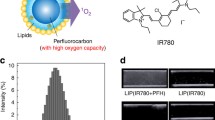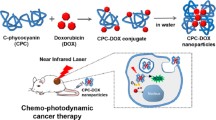Abstract
Photodynamic therapy (PDT) is a treatment modality, in which photosensitizers are activated by light of appropriate wavelength to convert molecular oxygen from triplet state (3O2) to singlet (1O2) that kills nearby cancer cells. However, the clinical application of PDT is limited to treat tumors on or just below the skin or the lining of internal organs because the light needed cannot pass through more than 1 cm of tissues. Here, we report chemi-dynamic nanoparticles (CDNP) as a light-free photodynamic therapeutic system based on peroxalate chemiluminescence. Photosensitizers are excited by the energy generated from hydrogen peroxide-mediated degradation of peroxalate to generate singlet oxygen to kill cancer cells. CDNP kill cancer cells without external light and hold potential as new anticancer drugs.

Similar content being viewed by others
References
R. Siegel, J. Ma, Z. Zou, and A. Jemal, CA Cancer J. Clin., 64, 9 (2014).
A. B. Mariotto, K. R. Yabroff, Y. Shao, E. J. Feuer, and M. L. Brown, J. National Cancer Institute, 103, 117 (2011).
I. Diamond, A. McDonagh, C. Wilson, S. Granelli, S. Nielsen, and R. Jaenicke, Lancet, 300, 1175.
E. E. Kelley, F. E. Domann, G. R. Buettner, L. W. Oberley, and C. P. Burns, J. Photochem. Photobiol. B: Biol., 40, 273 (1997).
Z. Huang, H. Xu, A. D. Meyers, A. I. Musani, L. Wang, R. Tagg, A. B. Barqawi, and Y. K. Chen, Technol. Cancer Res. Treatment, 7, 309 (2008).
M. Alexiades-Armenakas, Clinics Dermatol., 24, 16 (2006).
R. Aquaron, O. Forzano, J.L. Murati, G. Fayet, C. Aquaron, and B. Ridings, Cell. Mol. Biol. (Noisy-le-Grand, France), 48, 925 (2002).
M. B. Vrouenraets, G. W. M. Visser, G. B. Snow, and G. van Dongen, Anticancer Res., 23, 505 (2003).
A. L. Rose and T. D. Waite, Anal. Chem., 73, 5909 (2001).
L. P. da Silva and J. da Silva, Chemphyschem, 13, 2257 (2012).
C. M. Magalhaes, J. da Silva, and L. P. da Silva, Chemphyschem, 17, 2286 (2016).
R. Laptev, M. Nisnevitch, G. Siboni, Z. Malik, and M. A. Firer, British J. Cancer, 95, 189 (2006).
T. Theodossiou, J. S. Hothersall, E. A. Woods, K. Okkenhaug, J. Jacobson, and A. J. MacRobert, Cancer Res., 63, 1818 (2003).
D. Lee, S. Khaja, J. C. Velasquez-Castano, M. Dasari, C. Sun, J. Petros, W. R. Taylor, and N. Murthy, Nat. Mater., 6, 765 (2007).
V. Nogueira and N. Hay, Clinical Cancer Research: An Official Journal of the American Association for Cancer Research, 19, 4309 (2013).
L. T. Lin, C. J. Tai, S. P. Chang, J. L. Chen, S. J. Wu, and C. C. Lin, Anticancer Agents Med. Chem., 13, 1565 (2013).
H. Ka, H.-J. Park, H.-J. Jung, J.-W. Choi, K.-S. Cho, J. Ha, and K.-T. Lee, Cancer Lett., 196, 143 (2003).
Y. H. Seo, A. Singh, H.-J. Cho, Y. Kim, J. Heo, C.-K. Lim, S. Y. Park, W.-D. Jang, and S. Kim, Biomaterials, 84, 111 (2016).
B. Kim, E. Lee, Y. Kim, S. Park, G. Khang, and D. Lee, Adv. Funct. Mater., 23, 5091 (2013).
S. Park, J. Yoon, S. Bae, M. Park, C. Kang, Q. Ke, D. Lee, and P. M. Kang, Biomaterials, 35, 5944 (2014).
D. Yoo, K. Guk, H. Kim, G. Khang, D. Wu, and D. Lee, Int. J. Pharm., 450, 87 (2013).
D. Lee, S. Bae, Q. Ke, J. Lee, B. Song, S.A. Karumanchi, G. Khang, H. S. Choi, and P. M. Kang, J. Control. Release, 172, 1102 (2013).
Z. Liu, D. Liu, L. Wang, J. Zhang, and N. Zhang, Int. J. Mol. Sci., 12, 1684 (2011).
Y.-T. Yang, C.-T. Chen, J.-C. Yang, and T. Tsai, AAPS J., 12, 138 (2010).
A. Gomes, E. Fernandes, and J. L. F. C. Lima, J. Biochem. Biophys. Methods, 65, 45 (2005).
V. Rapozzi, S. Zorzet, M. Zacchigna, E. Della Pietra, S. Cogoi, and L. E. Xodo, Mol. Cancer, 13, 75 (2014).
S.-N. Jung, D.-S. Shin, H.-N. Kim, Y. J. Jeon, J. Yun, Y.-J. Lee, J. S. Kang, D. C. Han, and B.-M. Kwon, Biochem. Pharmacol., 97, 38 (2015).
J. Noh, B. Kwon, E. Han, M. Park, W. Yang, W. Cho, W. Yoo, G. Khang, and D. Lee, Nat. Commun., 6, 6907 (2015).
D. J. Taatjes, B. E. Sobel, and R. C. Budd, Histochem. Cell Biol., 129, 33 (2008).
C. D. Bortner and J. A. Cidlowski, J. Biol. Chem., 278, 39176 (2003).
S. G. Bown, A. Z. Rogowska, D. E. Whitelaw, W. R. Lees, L. B. Lovat, P. Ripley, L. Jones, P. Wyld, A. Gillams, and A. W. Hatfield, Gut, 50, 549 (2002).
Author information
Authors and Affiliations
Corresponding author
Additional information
Acknowledgments: This work was supported by a grant of Korean Health Technology R&D Project (HI15C1619), Ministry of Health & Welfare and Basic Science Research Program (2016R1A2B4008489) through National Research Foundation funded by the Ministry of Education, Republic of Korea.
Rights and permissions
About this article
Cite this article
Berwin Singh, S.V., Kim, J., Park, H. et al. Novel chemi-dynamic nanoparticles as a light-free photodynamic therapeutic system for cancer treatment. Macromol. Res. 25, 749–755 (2017). https://doi.org/10.1007/s13233-017-5078-9
Received:
Revised:
Accepted:
Published:
Issue Date:
DOI: https://doi.org/10.1007/s13233-017-5078-9




